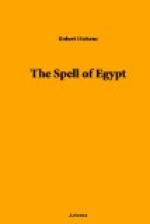Not so Queen Hatshepsu. More artful in her generation, she set her long but little temple against the precipices of Libya. And what is the result? Simply that whenever one looks toward them one says, “What are those little pillars?” Or if one is more instructed, one thinks about Queen Hatshepsu. The precipices are as nothing. A woman’s wile has blotted them out.
And yet how grand they are! I have called them tiger-colored precipices. And they suggest tawny wild beasts, fierce, bred in a land that is the prey of the sun. Every shade of orange and yellow glows and grows pale on their bosses, in their clefts. They shoot out turrets of rock that blaze like flames in the day. They show great teeth, like the tiger when any one draws near. And, like the tiger, they seem perpetually informed by a spirit that is angry. Blake wrote of the tiger:
“Tiger, tiger,
burning bright
In the forests of the
night.”
These tiger-precipices of Libya are burning things, avid like beasts of prey. But the restored apricot-colored pillars are not afraid of their impending fury—fury of a beast baffled by a tricky little woman, almost it seems to me; and still less afraid are the white pillars, and the brilliant paintings that decorate the walls within.
As many people in the sad but lovely islands off the coast of Scotland believe in “doubles,” as the old classic writers believed in man’s “genius,” so the ancient Egyptian believed in his “Ka,” or separate entity, a sort of spiritual other self, to be propitiated and ministered to, presented with gifts, and served with energy and ardor. On this temple of Deir-el-Bahari is the scene of the birth of Hatshepsu, and there are two babies, the princess and her Ka. For this imagined Ka, when a great queen, long after, she built this temple, or chapel, that offerings might be made there on certain appointed days. Fortunate Ka of Hatshepsu to have had so cheerful a dwelling! Liveliness pervades Deir-el-Bahari. I remember, when I was on my first visit to Egypt, lunching at Thebes with Monsieur Naville and Mr. Hogarth, and afterward going with them to watch the digging away of the masses of sand and rubbish which concealed this gracious building. I remember the songs of the half-naked workmen toiling and sweating in the sun, and I remember seeing a white temple wall come up into the light with all the painted figures surely dancing with joy upon it. And they are surely dancing still.
Here you may see, brilliant as yesterday’s picture anywhere, fascinatingly decorative trees growing bravely in little pots, red people offering incense which is piled up on mounds like mountains, Ptah-Seket, Osiris receiving a royal gift of wine, the queen in the company of various divinities, and the terrible ordeal of the cows. The cows are being weighed in scales. There are three of them. One is a philosopher, and reposes with an air that says, “Even this last indignity of being weighed against my will




